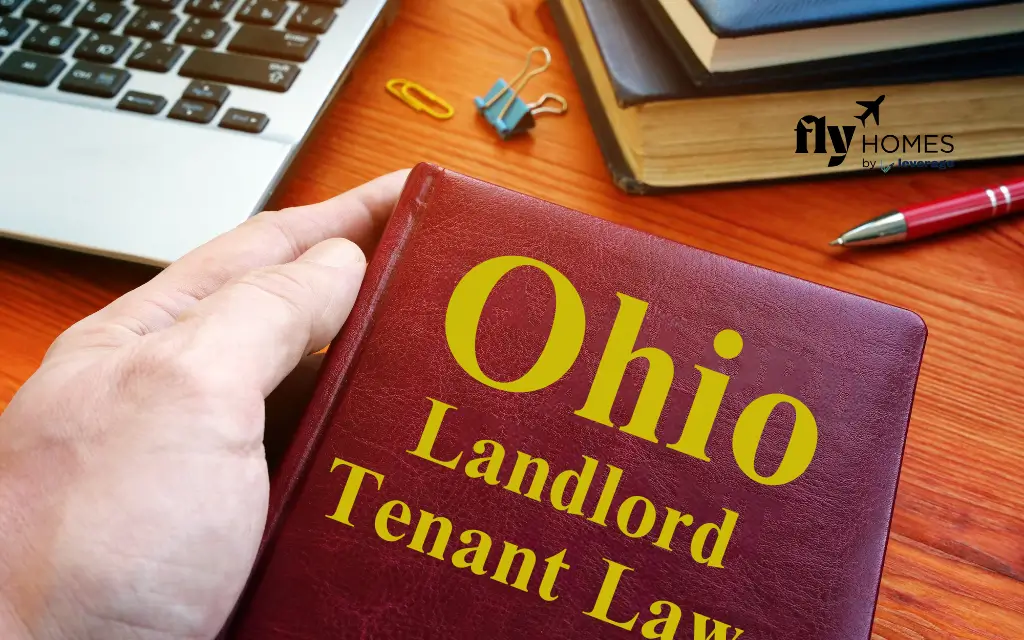Moving to Ohio as an international student is an exciting journey, but finding the right place to live comes with responsibility. To avoid confusion and protect yourself legally, it’s important to understand Ohio Landlord-Tenant Law.
Whether you’re renting for the first time or have some experience, knowing your rights and duties as a tenant can help prevent problems with landlords and ensure a smooth rental experience. This guide will explain key parts of the law—like leases, rent, maintenance, and eviction—in simple terms, so you can settle into your new home with confidence.
Table of contents
- What is Ohio Landlord-Tenant Law?
- Responsibilities of Rental Parties Under Ohio Landlord-Tenant Law
- Retaliatory Eviction in Ohio Landlord-Tenant Law?
- What to Do If the Landlord Doesn’t Fix Problems?
- Eviction Process in Ohio Landlord-Tenant Law
- Important Ohio Landlord-Tenant Law Protections for Students
- FAQS on the Ohio Landlord Tenant Law
What is Ohio Landlord-Tenant Law?
Ohio Landlord-Tenant Law, established in 1974, governs the relationship between landlords and tenants in the state. These laws ensure that both parties are aware of their rights and obligations when it comes to renting property. Whether you have a written lease agreement or a verbal understanding, Ohio Landlord-Tenant Law is designed to protect both landlords and tenants.
Ohio Landlord-Tenant Law covers everything from how a lease should be handled to resolving disagreements. These laws protect both landlords and tenants, whether you have a written lease or a verbal agreement. Understanding Ohio Landlord-Tenant Law is especially crucial for international students in Ohio, as it governs issues such as security deposits and eviction processes.
Also Read: Planning to study abroad? Well, check out our blog on the best places to study abroad in the US to avail world-class education.
Responsibilities of Rental Parties Under Ohio Landlord-Tenant Law
Under Ohio Landlord-Tenant Law, both landlords and tenants have specific responsibilities to ensure a safe and harmonious rental experience. These duties are designed to protect both parties and maintain the condition of the rental property.
Whether you’re a tenant or a landlord, understanding these responsibilities is crucial to avoiding conflicts and ensuring compliance with Ohio’s legal requirements. Here’s a breakdown of the key responsibilities of rental parties under Ohio landlord-tenant law.
Landlord Responsibilities According to Ohio Law:
- Health & Safety: Under Ohio Landlord-Tenant Law, landlords are required to maintain the property in a safe and habitable condition, ensuring that it meets health and safety codes.
- Repairs and Maintenance: Landlords must handle repairs and provide essential services like heating, water, and electricity.
- Access:Ohio Landlord-Tenant Law mandates that landlords give tenants reasonable notice before entering the rental unit for repairs or inspections.
- Communication: Landlords are required to provide tenants with written contact information for easy communication.
Tenant Responsibilities According to Ohio Law::
- Property Care: According to Ohio Landlord-Tenant Law, tenants must maintain the rental property in good condition, keeping it clean and free from damage.
- Proper Use of Utilities: Tenants should use plumbing, electrical systems, and other fixtures correctly.
- Respecting Neighbors: Tenants must not disturb neighbors or engage in behavior that could harm the property or the peace of the building.
- Allowing Access: Tenants must permit landlords to enter the property for inspections or necessary repairs, provided reasonable notice is given.
Retaliatory Eviction in Ohio Landlord-Tenant Law?
Retaliatory eviction occurs when a landlord attempts to evict a tenant or penalize them after the tenant has made a legitimate complaint, such as reporting unsafe conditions. If a tenant reports an issue and the landlord raises the rent, reduces services, or begins eviction proceedings, this could be considered retaliatory under Ohio Landlord-Tenant Law.
What You Should Know:
- If retaliatory eviction occurs, tenants can contest the eviction in court.
- Landlords still have the right to evict tenants for valid reasons, like non-payment of rent.
What to Do If the Landlord Doesn’t Fix Problems?
If a landlord neglects to address significant issues affecting health and safety, tenants have a few options under Ohio Landlord-Tenant Law:
- Written Request: Notify the landlord in writing, asking for repairs.
- Court Intervention: If no action is taken within 30 days, tenants can deposit rent into an escrow account with the court or even end the lease.
- Note: This does not apply to landlords with fewer than three rental units.
These actions come with rules, and they don’t apply to small landlords with fewer than three rental units.
Also Read: If you are looking for accommodation in Los Angeles, Check Out our blog on Cheapest Student Accommodations in Los Angeles
Eviction Process in Ohio Landlord-Tenant Law
According to the Ohio landlord-tenant law, eviction is a legal process where a landlord seeks to remove a tenant from the property, usually due to non-payment of rent or breach of lease terms.
Steps in the Eviction Process under Ohio Landlord-Tenant Law:
- Notice of Eviction: A landlord must give at least a 30-day notice to the tenant before initiating the eviction process.
- Filing for Eviction: If the tenant does not leave after the notice, the landlord can file for eviction in court. Tenants can contest the eviction if they believe it is unjustified.
- Security Deposit: When a tenant moves out, the landlord has 30 days to return the security deposit, minus any deductions for damages or unpaid rent.
- Interest on Security Deposit: If the landlord holds a deposit higher than one month’s rent, they must pay 5% annual interest on the excess amount after six months.
Important Ohio Landlord-Tenant Law Protections for Students
As an international student, it’s crucial to understand the specific protections provided by Ohio Landlord-Tenant Law that can affect your rental experience. These laws cover a range of issues from rent control to maintenance responsibilities. Knowing your rights can give you peace of mind and help you avoid potential conflicts with your landlord.
FAQS on the Ohio Landlord Tenant Law
Renters in Ohio must follow several rules under Ohio Landlord-Tenant Law to maintain their tenancy. They are required to keep the property clean, avoid causing damage, and comply with health and safety standards. Renters should also pay their rent on time and use the property for its intended purpose.
Tenants in Ohio generally cannot refuse reasonable entry to their landlord under Ohio Landlord-Tenant Law, especially if the landlord provides proper notice, usually 24 hours. This entry is allowed for necessary inspections and repairs, or to show the property to prospective tenants or buyers.
Yes, Ohio is considered a landlord-friendly state due to its relatively straightforward eviction process and reasonable regulations on rent control. These factors make Ohio Landlord-Tenant Law more favorable to property owners than to tenants.
Under Ohio landlord-tenant law, a landlord is prohibited from taking certain actions, including:
– a landlord is prohibited from disconnecting utilities, changing the locks, or threatening such actions in an attempt to force you to vacate the property.
A landlord cannot harass you by repeatedly demanding entry into the property, entering without valid reason, or visiting at unreasonable times.
In Ohio, landlords must provide at least 30 days’ written notice to terminate a month-to-month tenancy under Ohio landlord-tenant law. For fixed-term leases, notice is not required to end the lease unless specified in the agreement. If a tenant is in violation, a shorter notice, such as 3 days, may apply.
In Ohio, there are no statewide rent control laws, so landlords are generally free to raise rent by any amount they choose.
In Ohio, a landlord cannot evict a tenant immediately. If the tenant adheres to the lease terms, they can stay until the lease ends according to Ohio landlord-tenant law. However, if the tenant remains after the lease expires without renewal, the landlord can issue a 7-Day or 30-Day Notice to Quit.
Ohio is regarded as a landlord-friendly state due to the minimal or lack of regulations concerning rent control policies and mandatory disclosures. As a result, landlords in Ohio have greater flexibility when setting and raising rent prices.
In Ohio, a tenant has the right to refuse entry to a landlord according to Ohio landlord-tenant law. However, consent should not be unreasonably withheld when the landlord needs to enter for purposes such as making repairs, inspecting the property, or showing the unit to prospective tenants, buyers, or contractors.
According to Ohio landlord-tenant law, if the landlord fails to complete the necessary repairs within 30 days, the tenant has the option to either establish a rent escrow account with the municipal court or end the lease agreement. If opting for escrow, the tenant will pay their rent to the court each month instead of directly to the landlord.
Hope you liked reading about the Ohio Landlord-Tenant Law. Reach out to Fly Homes now at 1800572118 to secure the finest accommodation abroad.
Follow Us on Social Media




























